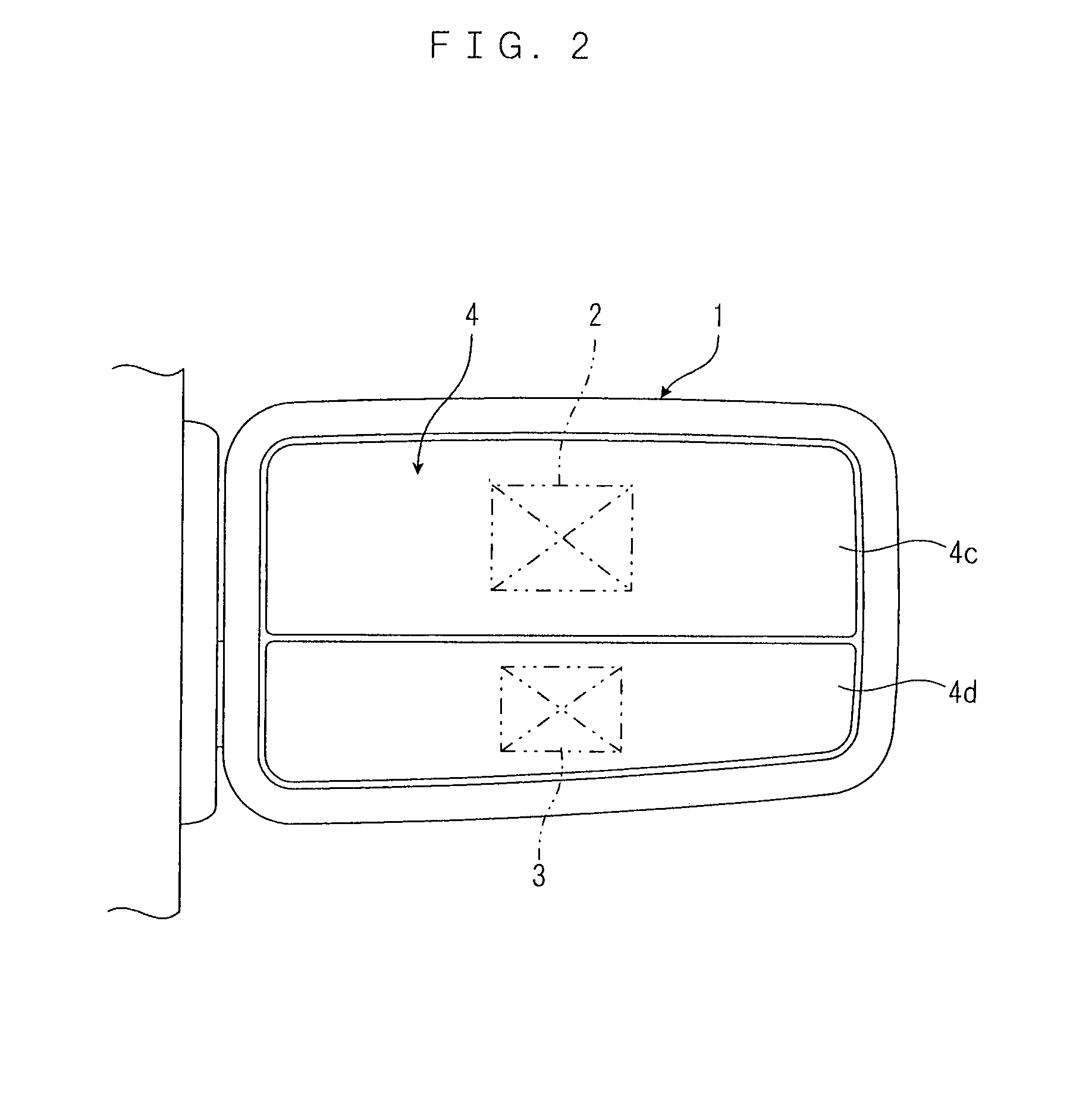Door mirror
a technology for door mirrors and mirrors, applied in mirrors, instruments, mountings, etc., can solve the problems of difficult to view the rear wheel portion, difficult to make sure of the safety behind the vehicle's body, and difficult to make sure of the safety around the rear wheels, etc., and achieve the effect of high adaptability
- Summary
- Abstract
- Description
- Claims
- Application Information
AI Technical Summary
Benefits of technology
Problems solved by technology
Method used
Image
Examples
embodiment 1
[0036]In a door mirror 1 shown in FIG. 1, its mirror surface 4 for reflecting what is behind a vehicle's body is divided into two parts: an inner part which is nearer to the vehicle's body; and an outer part which is farther away from the vehicle's body, and reflection angles of the two divided mirror surfaces 4a, 4b can be arbitrarily changed respectively by reflection angle adjusting mechanisms 2, 3 mounted on the rear faces of the inner part and outer part divided mirror surfaces 4a, 4b, as shown by dotted lines in FIG. 1. The mechanisms for adjusting the reflection angles of the mirror surfaces are of the same types as the conventionally used ones, and their structures may be explained as follows. The reflection angle adjusting mechanism 2 includes a vertical shaft 2a and a horizontal shaft 2b intersecting crosswise in a cross shape. The vertical shaft 2a is supported by bearings 2c fixed to a casing 1c of the door mirror, while the horizontal shaft 2b is supported by bearings 2...
embodiment 2
[0044]The door mirror in accordance with embodiment 2, a cross section of which is shown in FIG. 4, is so designed that the reflection angles of the right-hand and left-hand divided mirror surfaces are arbitrarily adjustable by reflection angle adjusting mechanisms 2, 3, and the outer-side mirror surface 4b can be extended, integrally with the reflection angle adjusting mechanism 3, to project outward of a lateral face 1a of the door mirror 1 by a turning mechanism 7 including a slide link mechanism, as shown in FIGS. 5 and 6.
[0045]This turning mechanism 7 is co-axially supported by the shaft of a pinion 8 together with a guide rail 7a provided on the inside face of a casing 1c pendicularly to the mirror surface 4b, a slider 7b that slides along the guide rail 7a, the pinion 8 supported by a shaft perpendicular to the sliding direction of the slider 7b, and a rack 9 provided at the end of the stroke of the slider 7b. A turning arm 10 of which front portion is bent in a reversed J sh...
embodiment 3
[0062]In the door mirror 1 in accordance with embodiment 3, the reflection angles of its divided mirror surfaces 4a, 4b are made adjustable by reflection angle adjusting mechanisms 2, 3 having the same structure as those of embodiment 1 and the divided mirror surface 4b on the outer side, together with the outer side face 1d of the casing 1c, can be turned to project from the casing 1c laterally outward of the outer side face of the door mirror 1.
[0063]In other words, the divided mirror surface 4b of the door mirror 1 in accordance with the embodiment 3 is attached to a curved arm 10b extended from the shaft 12 toward the outer periphery via the reflection angle adjusting mechanism 3, and its outside portion is integrated with a side face member 1d that forms the side face portion of the door mirror 1.
[0064]The shaft 12 is provided with the pulley 22 and the gear rotating shaft 19 of the door mirror 1 is coaxially provided with the pulley 23, the power transmission belt 24 is wound ...
PUM
 Login to View More
Login to View More Abstract
Description
Claims
Application Information
 Login to View More
Login to View More - R&D
- Intellectual Property
- Life Sciences
- Materials
- Tech Scout
- Unparalleled Data Quality
- Higher Quality Content
- 60% Fewer Hallucinations
Browse by: Latest US Patents, China's latest patents, Technical Efficacy Thesaurus, Application Domain, Technology Topic, Popular Technical Reports.
© 2025 PatSnap. All rights reserved.Legal|Privacy policy|Modern Slavery Act Transparency Statement|Sitemap|About US| Contact US: help@patsnap.com



